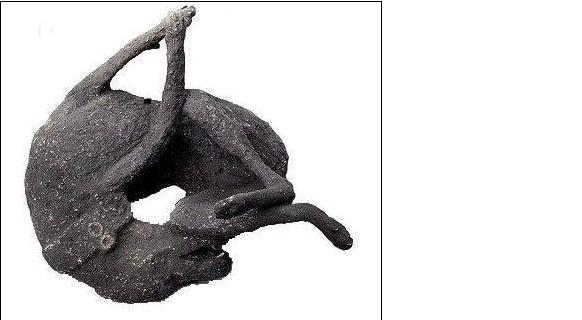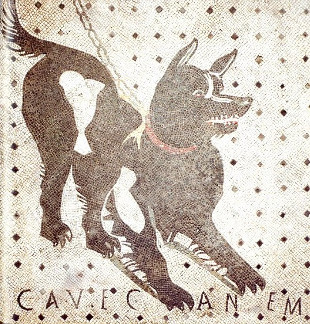The eruption of the Vesuvius in the afternoon of the 24th of August of the year 79 (such an accurate date is in dispute) destroyed the lively and jovial city of Pompeii, near Naples (Neapolis = new city) and paradoxically preserved its ruins for centuries, until the year 1748.
The city tour impresses millions of visitors who have the opportunity to walk through an authentic Roman city that is remarkably well preserved.
Among the many things that can impress us specially stands out the realistic picture of a dog, buried by the ash, which could not escape because he was tied with a chain at the entrance of the house of his owner, Marcus Veronius Primus. He was found on the 20th of November, in 1874. We can imagine the struggle of the poor animal trying to escape the ashes as they were gradually covering him. Probably he died before asphyxiated by the volcanic gases or the lack of oxygen. His body, like that of other human and organic beings, by decomposing left his mold which filled with plaster has left us this dramatic figure.

The dog is the first animal that has been domesticated by men, the first that lives with men as it is attested by archaeological sites from the Paleolithic. Indeed, in these fields or deposits never appear dog bones eaten by man.
The dog is present in every culture of the Antiquity. It is the faithful friend of man, the only one who recognized Odysseus, Ulysses, when he returned to his palace in Ithaca.
The Romans had dogs at home. The image above evidence it but no less than this other image that shows a mosaic at the entrance (fauces in Latin) with the figure of a dog and the inscription cave canem (beware of the dog). The mosaic is part of the called "House of the Tragic Poet", so called because in it there is a mosaic showing a theatrical scene.

Nowadays, nearly two thousand years later, we continue to practice the same habit and there are many homes or detached houses whose doors show the same admonishing inscription: take care of the dog.
Otherwise, the dog was such a good keeper of the property, that in Greco-Roman mythology it was made guardian of Hell, of the underworld, of the next life world. It is the famous Canis Cerberus, Canceberus (from “canis” = dog, and “cerberus”, from the Greek Κέρβερος Kérberos = demon of the abyss), three-headed dog that prevents the departure of the Hades to those who have already finished or completed their earthly life. It´s also called the dog of Hell.
The word "canis" in educated or technical Spanish terms remains as “can, canino, cánido” and “canícula”= (summer) (heat up period, related to the emergence of Sirius, a star of the constellation Canis Maior).
"Perro" (in English “dog”) instead is an exclusively Spanish word of obscure source. Corominas thinks it is an onomatopoeia (term that imitates the sound of its own meaning) that reproduces the sound of the dog´s growl perrr perrr which herdsmen called his faithful assistant with.
Canis itself has passed to the French as “chien”, to the Italian as “cane”, to the Galician as “can” and to the Portuguese cão.

